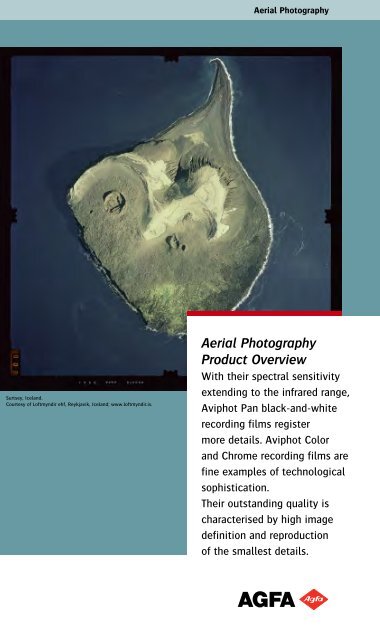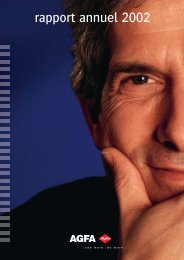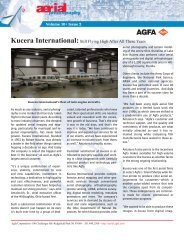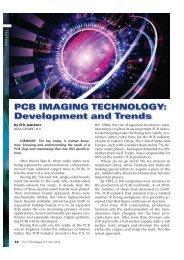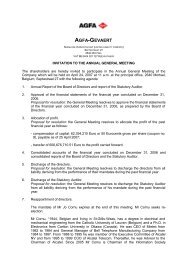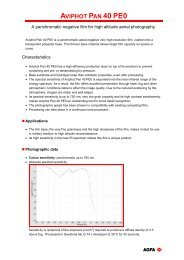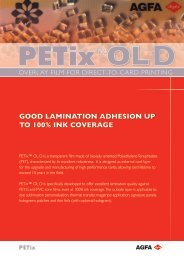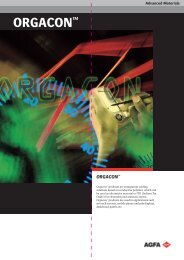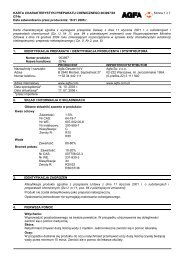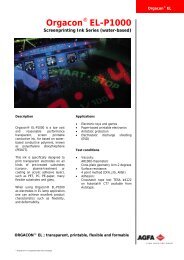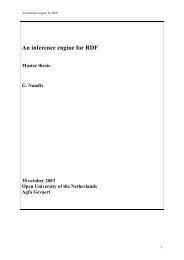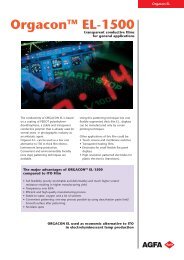Agfa Aerial
Agfa Aerial
Agfa Aerial
Create successful ePaper yourself
Turn your PDF publications into a flip-book with our unique Google optimized e-Paper software.
<strong>Aerial</strong> Photography<br />
Surtsey, Iceland.<br />
Courtesy of Loftmyndir ehf, Reykjavik, Iceland; www.loftmyndir.is.<br />
<strong>Aerial</strong> Photography<br />
Product Overview<br />
With their spectral sensitivity<br />
extending to the infrared range,<br />
Aviphot Pan black-and-white<br />
recording films register<br />
more details. Aviphot Color<br />
and Chrome recording films are<br />
fine examples of technological<br />
sophistication.<br />
Their outstanding quality is<br />
characterised by high image<br />
definition and reproduction<br />
of the smallest details.
Black-and-white<br />
> Camera Films Use Processing Features/Benefits<br />
Aviphot Pan 80 PE1<br />
Aviphot Pan 80 PE0<br />
High resolution, intermediate<br />
speed, extremely fine grain<br />
panchromatic negative film.<br />
Low to high altitude flights.<br />
Continuous tone processor or<br />
rewind development.<br />
Developer: G 74 c or<br />
G 74 c + AD 74.<br />
Fixer: Pfix + Aditan.<br />
- Protection layer to prevent scratching.<br />
- Excellent penetration through haze: sharp images.<br />
- Clear differentiation of species in agricultural and ecological studies.<br />
- Control of image contrast: the film can be processed as a low contrast film for large scale photography or as a<br />
high contrast film for other applications. Average gradient between 0.9 and 1.9.<br />
Aviphot Pan 200 PE1<br />
Aviphot Pan 200 PE0<br />
Aviphot Pan 200 PE0-AR<br />
Medium speed, fine grain<br />
panchromatic negative film.<br />
Low to medium altitude flights.<br />
Continuous tone processor or<br />
rewind development.<br />
Developer: G 74 c or<br />
G 74 c + AD 74.<br />
Fixer: Pfix + Aditan<br />
- Excellent penetration through haze: higher image contrast and therefore more information.<br />
- No special recording filters required. Yellow filters can be used to get a higher image contrast.<br />
- Average gradient can vary between 0.8 and 1.6.<br />
- Higher speed means shorter exposure times, smaller apertures (= higher sharpness over the entire image) and<br />
more flying hours per day.<br />
Aviphot Pan 400S PE1<br />
Aviphot Pan 400S PE0<br />
High speed, low fog, fine grain<br />
panchromatic negative film.<br />
Short photo-flights under different<br />
conditions.<br />
Low sun angle flights.<br />
Continuous tone processor or<br />
rewind development.<br />
Developer: G 74 c or<br />
G 74 c + AD 74.<br />
Fixer: Pfix + Aditan.<br />
- Excellent penetration through haze: also suitable for flying in poor weather conditions.<br />
- No special recording filters required.<br />
- Low fog, even at long processing times or processing at higher temperature.<br />
- High sensitivity: suitable for poor light conditions.<br />
- High resolution due to fine grain and highly efficient anti-halation layer.<br />
- Average gradient variation between 0.6 and 1.1 in function of the developing time.<br />
- Wide exposure latitude prevents under- or overexposure.<br />
> Copying Films Use Processing Features/Benefits<br />
Avitone P 1 p<br />
Avitone P 3 p<br />
Negative acting, orthochromatic<br />
continuous tone film for<br />
making diapositives from<br />
black-and-white originals.<br />
Duplicating continuous tone negatives<br />
either in contact (with or without<br />
electronic contrast modulation) or<br />
by projection for enlargements.<br />
Duplicates for cartographic and<br />
military applications.<br />
Continuous tone<br />
(G 74 c) processing.<br />
Rapid access processing.<br />
- Suitable for copying medium to fine grain recording films.<br />
- Extremely fine grain emulsion: enhanced contrast through reproduction.<br />
- Average gradient of 1.3 to 1.6 can be reached by adjusting the developing time.<br />
- Dimensionally stable duplicates under controlled processing conditions.<br />
Avitone P 1 p-HR<br />
Avitone P 3 p-HR<br />
Negative acting, blue sensitive<br />
very high resolution film for<br />
making diapositives from blackand-white<br />
originals.<br />
Duplication of continuous tone<br />
negatives, either in contact or<br />
by projection.<br />
Duplicates for cartographic and<br />
military applications.<br />
Easy reproduction of identical copies.<br />
Ideal for copying high altitude<br />
reconnaissance originals.<br />
Easy scanning on digital scanners.<br />
Continuous tone<br />
(G 74 c) processing.<br />
Rapid access processing.<br />
- Extremely fine grain film suitable for copying high altitude films with extremely high resolution.<br />
- Average gradient of 0.8 to 1.0 in G 74 c developer.<br />
- Neutral grey, low fog copies.<br />
- Dimensionally stable duplicates under monitored processing conditions.<br />
- Can be used in processors with short fixing and drying times.<br />
- High scratch-resistance and secure film conveying in fast duplicators.<br />
Avitone PD 1 p-OS<br />
Avitone PD 3 p-OS<br />
Orthochromatic continuous tone<br />
diapositive film.<br />
Duplicates and enlargements<br />
(negative/negative) of continuous tone<br />
negatives.<br />
Various continuous tone applications.<br />
For making identical copies for the Open<br />
Skies project.<br />
Continuous tone<br />
(G 74 c) processing.<br />
Rapid access processing.<br />
- Suitable for copying medium to fine grain recording films.<br />
- High resolution due to fine grain structure and anti-halation layer.<br />
- Large contrast range for copying negatives with varying image contrast or different density range.<br />
- Average gradient may vary between 1.0 and 1.3, enabling gradation control and optimum image quality in<br />
continuous tone processing.<br />
- Absolutely neutral silver image.<br />
- Low fog, average gradation of 1.0 and high maximum density make these films suitable for identical copies.<br />
> Papers Use Processing Features/Benefits<br />
Rapitone M1 and M2<br />
Photographic black-and-white<br />
paper with variable contrast<br />
through the use of coloured<br />
filters.<br />
Semi-matt and glossy surface.<br />
Enlargements.<br />
Contact prints.<br />
Mosaics.<br />
Continuous tone<br />
(G 74 c) processing.<br />
Rapid access processing.<br />
In activator.<br />
- Gradual variation of the gradation from extra low to very high contrast by using standard<br />
black-and-white enlargers with multi-contrast filters or enlargers equipped with a colour head or filter head<br />
for multi-contrast paper.<br />
- Copied image is black on a white background.<br />
- Contrast increase and/or decrease within one image through partial exposures with different<br />
filter combinations.
Colour<br />
> Recording Films Use Processing Features/Benefits<br />
Aviphot Color X100 PE1<br />
Panchromatic negative colour<br />
film without colour mask.<br />
Low, medium and high altitude flights,<br />
between 1,500 and 25,000 ft.<br />
ASP 70 Process, compatible<br />
with C-41 and AN-6 processing.<br />
- Very high definition and very low granularity: ideal for cartographic image acquisition and interpretation.<br />
- Wide contrast range through push processing by increasing either the developing time or the developer<br />
temperature.<br />
- Low contrast at standard processing, excellent shadow detail.<br />
- Suitable for electronic image scanning: reproduction of clean and saturated colours without additional colour<br />
correction for compensation of mask colour.<br />
- No colour mask: faster reproduction, easy focus, direct use in stereoplotter.<br />
Aviphot Color X400 PE1<br />
Panchromatic negative colour<br />
film without colour mask.<br />
Low, medium and high altitude flights,<br />
between 1,500 ft. and 15,000 ft.<br />
ASP 70 Process, compatible<br />
with C-41 and AN-6 processing.<br />
- High speed and low granularity, ideal for photography in low light conditions or from unstable platforms.<br />
- Low contrast at standard processing, particularly suitable for low sun angle photography.<br />
- No colour mask: faster reproduction, easy focus, direct use in stereo-plotter and high signal/noise in<br />
electronic imagery.<br />
- Suitable for electronic image scanning: reproduction of clean and saturated colours without additional colour<br />
correction (no colour mask).<br />
Aviphot Color N800 PE1<br />
Panchromatic negative<br />
colour film.<br />
Low to medium altitude flights<br />
(2,500 to 15,000 ft) or very poor<br />
lighting conditions.<br />
ASP 70 Process, compatible<br />
with C-41.<br />
- Minimum granularity, high definition and very high speed.<br />
- Excellent image quality and very good resolution.<br />
- Perfectly balanced colour saturation for low and medium altitude flying.<br />
- Pure, faithful colours: colour contamination is avoided by the triple masking technique.<br />
- Wide exposure latitude limits the need for repeat flights.<br />
Aviphot Chrome 200 PE1<br />
Panchromatic colour<br />
reversal film.<br />
Low to medium altitude flights<br />
(2,500 to 15,000 ft).<br />
ASP 44 Process, compatible<br />
with E-6 chemistry.<br />
- Sharp, low grain positive image.<br />
- Can be pushed in speed, without change in contrast.<br />
- Natural colours, very good colour saturation.<br />
- Excellent shadow detail.<br />
> Copying Films Use Processing Features/Benefits<br />
Avitone CP 70<br />
Negative colour copying film<br />
for making diapositives.<br />
For making highest quality diapositives<br />
from aerial negatives, for use in orthoplotters.<br />
Scanning of diapositives without loss<br />
of resolution or information.<br />
ASP 70 Process,<br />
compatible with C-41 chemistry.<br />
<strong>Agfa</strong>color Process AP 94,<br />
compatible with RA-4 chemistry.<br />
- Medium colour saturation, high brilliance.<br />
- Extra fine grain and ultimate sharpness.<br />
- Low contrast for rendering shadow details.<br />
- Good dimensional stability due to the 0.175 mm polyester base.<br />
Avitone CP 94<br />
Negative colour copying film<br />
for making diapositives.<br />
Photogrammetry: for making diapositives<br />
from aerial negatives, for use in<br />
orthoplotters.<br />
Transparency displays.<br />
ASP 94 Process,<br />
compatible with RA-4 chemistry.<br />
- High colour saturation and brilliance.<br />
- Optimised contrast range.<br />
- Excellent sharpness.<br />
- Fast and accurate, for use on dodging printers.<br />
- Good colour stability due to the use of true-colour dyes and UV-absorbers.<br />
- Good dimensional stability due to the 0.175 mm polyester base.<br />
> Papers Use Processing Features/Benefits<br />
Rapitone C1 and C2<br />
Photographic continuous tone<br />
colour paper.<br />
Enlargements.<br />
Contact copies in automatic contact<br />
frames.<br />
Mosaics.<br />
ASP 94 Process,<br />
compatible with RA-4 chemistry.<br />
- High colour saturation and brilliance.<br />
- Fast and accurate, for use on dodging printers.<br />
- Glossy and semi-matt surface.
ASP 70 process in roller transport processors<br />
Process solution Time Temperature (°C) Replenishment<br />
rate (guideline)<br />
Developer 70 CD-R / Starter 70 CD-S 3 min 15 s 37.8 ± 0.25 1075 ml/m 2<br />
Bleach 70 BL-R /acetic acid 60% 4 min 20 s 38 ± 3 810 ml/m 2<br />
Wash 1 min 5 s 38 ± 3 -<br />
Fixer FX univ or FX Unifix 4 min 20 s 38 ± 3 810 ml/m 2<br />
Wash 3 min 15 s 38 ± 3 -<br />
Final bath 70 FI 1 min 5 s 24 - 41 810 ml/m 2<br />
Drying - max. 45 -<br />
To increase the contrast in a colour negative, the standard developing time and temperature can be changed.<br />
When pushing the development, the developing time can be increased to maximum 5 minutes 20 seconds.<br />
The temperature of the developer can also be increased to maximum 41 °C. Both pushing methods can be used<br />
either separately or simultaneously.<br />
ASP 44 process in roller transport processors<br />
Process solution Time Temperature (°C) Replenishment<br />
rate (guideline)<br />
1st Developer 44 FD-R / Starter FD-S 5 - 7 min 38 ± 0.3 2150 ml/m 2<br />
Wash 1 - 4 min 33 - 38 -<br />
Reversal bath 44 RE 1 - 4 min 24 - 39 1100 ml/m 2<br />
Colour developer 44 CD-R / Starter 44 CD-S 5 - 8 min 38 ± 0.6 2150 ml/m 2<br />
Pre-bleach 44 P BL 1 - 4 min 24 - 39 1100 ml/m 2<br />
Bleach 44 BL-R / Starter 44 BL-S 6 - 8 min 33 - 39 215 ml/m 2<br />
Fixer FX univ or FX unifix 4 - 6 min 33 - 39 1100 ml/m 2<br />
Wash 2 - 4 min 33 - 39 -<br />
Wash 2 - 4 min 33 - 39 -<br />
Final bath 44 FI 30 s - 4 min Room temperature 1100 ml/m 2<br />
Drying - Max. 45 -<br />
ASP 94 process in roller transport processors<br />
Process solution Time Temperature (°C) Replenishment<br />
Paper/Film Paper Film<br />
Colour Developer 45 s / 110 s* 35 ± 0.3 215 ml/m 2 500 ml/m 2<br />
94 CD-R / Starter 94 CD-S<br />
Colour Developer 45 s / 110 s 45 s / 110 s 160 ml/m 2 500 ml/m 2<br />
94 CD-LR / Starter 94 CD-S<br />
Bleach-Fix 45 s / 110 s 30 - 36 215 ml/m 2 500 ml/m 2<br />
94 BX-MR<br />
Wash 90 s / 220 s 30 - 40 2-5 ml/m 2 4-11 ml/m 2<br />
Drying - max. 80 (paper) - -<br />
max. 45 (film)<br />
* A developing time of 150 seconds guarantees neutral shadows, deep blacks where needed and a clean white colour.<br />
http://aerial.agfa.com<br />
aerial@agfa.com<br />
<strong>Agfa</strong>, the <strong>Agfa</strong>-rhombus, Aviphot, Avitone, Rapidoprint and Rapitone are<br />
trademarks of <strong>Agfa</strong>-Gevaert N.V., Belgium or its affiliates.<br />
Printed in Belgium<br />
© 2009 <strong>Agfa</strong>-Gevaert N.V., B-2640 Mortsel-Belgium<br />
NGJWS GB 00200901


